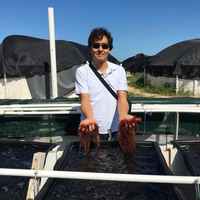Papers by Susana Fontinha
Listagem dos fungos, flora e fauna terrestres dos arquipelagos da Madeira e Selvagens = List of the terrestrial fungi, flora and fauna of Madeira and Selvagens archipelagos, 2008
DOAJ (DOAJ: Directory of Open Access Journals), Oct 1, 2010
In the Archipelago of Madeira four crop wild relatives of beets are native: Beta patula, Beta vul... more In the Archipelago of Madeira four crop wild relatives of beets are native: Beta patula, Beta vulgaris subsp. maritima, Patellifolia procumbens, and Patellifolia patellaris. All species are valuable genetic resources for the sugar beet breeding. Only in the very eastern part of the Madeira Island on the islet Ilhéu do Desembarcadouro and Ilhéu Chão the endemic species Beta patula can be found. On both islets the plant number of this very rare species, and of the two widely distributed species B. vulgaris subsp. maritima and P. procumbens was established and the habitat described. The results of the species census are presented. The establishment of a genetic reserve for Beta patula is suggested in this paper with the objective to protect this species more effectively.

Silva Lusitana, 2017
Efficient propagation of endangered plant species is a critical factor in successful ecological r... more Efficient propagation of endangered plant species is a critical factor in successful ecological restoration and conscientious habitat management. Hence, propagation trials of nine endemic plant species of Madeira (Anthyllis lemanniana Lowe, Armeria maderensis Lowe, Cedronella canariensis (L.) Webb & Berthel., Erica maderensis (Benth.) Bornm., Genista tenera (Jacq. ex Murray) Kuntze, Helichrysum melaleucum Rchb. ex Holl, Pericallis aurita (L'Her.) B. Nord., Sideritis candicans Aiton and Teline maderensis Webb & Berthel.) were carried out. Plant propagation requirements and their sexual and vegetative propagation methods were studied. Seed germination success varied between species. Germination rate exceeded 70% in six out of nine species, being lower than 30% in Pericallis aurita, while H. melaleucum seeds did not germinate. Vegetative propagation yielded lower success rates, with three species (Erica maderensis, Genista tenera and Teline maderensis) unable to establish roots, and three species (Helichrysum melaleucum, Pericallis aurita and Sideritis candicans) exceeding 60% of the rooting success. Establishment of the propagation requirements of these species could be regarded an important tool for supporting Madeira's flora conservation programs.
Agrobiodiversity conservation: securing the diversity of crop wild relatives and landraces
This chapter describes the ecogeographic analysis and provides the demographic baseline for Beta ... more This chapter describes the ecogeographic analysis and provides the demographic baseline for Beta patula, a rare species endemic to Madeira, Portugal. The importance of the establishment of a genetic reserve for this endangered species is also discussed.

Os modelos preditivos de distribuição de espécies são uma importante ferramenta para lidar com a ... more Os modelos preditivos de distribuição de espécies são uma importante ferramenta para lidar com a falta de informação biogeográfica existente para a maior parte dos taxa. Com esta técnica, estabelece -se uma relação entre a variável dependente (presença/ausência de uma espécie) e um conjunto de variáveis potencialmente preditoras, e é criado um mapa com a probabilidade de presença da espécie para uma determinada área de interesse. Neste capítulo, é usado o programa Maxent para criar modelos de distribuição potencial de um conjunto seleccionado de espécies, e os resultados obtidos são discutidos com base no conhecimento de especialistas nessas espécies.ABSTRACT: Predictive models of species distribution emerge as a valuable tool for tackling the lack of distributional information on most taxa. A function between the dependente variable (presence/absence of the species) and a set of potential predictors is established, and a map is generated for the focus area, indicating the probabili...
Nova Hedwigia, 2000
... A new Frullania species (subg. Frullania) from Deserta Grande, Madeira archipelago, Frullania... more ... A new Frullania species (subg. Frullania) from Deserta Grande, Madeira archipelago, Frullania sergiae sp. nov. Autores: M. Sim-Sim, S. Fontinha; Localización: Nova hedwigia, ISSN 0029-5035, Vol. 71, Nº 1, 2000 , págs. 185-194. Fundación Dialnet. ...

As ilhas atlânticas dos Açores, Madeira, Selvagens, Canárias e Cabo Verde constituem uma das regi... more As ilhas atlânticas dos Açores, Madeira, Selvagens, Canárias e Cabo Verde constituem uma das regiões da Europa mais ricas em diversidade de fungos, plantas e animais. Desde 2004 que a inventariação detalhada da diversidade destas ilhas tem sido um dos principais objectivos dos projectos ATLÂNTICO e BIONATURA (incluídos no projecto EU INTERREG IIIB). Este livro é a mais recente contribuição destes projectos, apresentando uma lista de todos os fungos, flora e fauna terrestre conhecida, incluindo a dulçaquícola, para dois arquipélagos atlânticos (Madeira e Selvagens). A lista abrange o arquipélago da Madeira, constituído por duas ilhas de maiores dimensões (Madeira e Porto Santo) e três pequenas, cujo conjunto constitui as Desertas (Ilhéu Chão, Deserta Grande e Bugio), e ainda o arquipélago das Selvagens, formado por duas pequenas ilhas (Selvagem Grande e Selvagem Pequena) e um ilhéu (Ilhéu de Fora).ABSTRACT: The Azores, Madeira, Selvagens, Canary Islands and Cape Verde are among the r...

Cryptogamie Bryologie, 2006
Il est difficile de reconnaitre les especes du genre Porella, connu pour sa grande plasticite phe... more Il est difficile de reconnaitre les especes du genre Porella, connu pour sa grande plasticite phenotypique. Des analyses genetiques et morphologiques ont ete realisees sur un grand echantillonnage d'especes europeennes et macaronesiennes (328 colonies collectees dans 150 localites environ) afin de i) definir les entites genetiques et ii) trouver les meilleurs caracteres permettant leur identification. Neuf especes sont ainsi reconnues, dont P. platyphylloidea avec des colonies du Canada incluses pour comparaison. La plupart des colonies de Porella sont multiclonales; elles presentent du polymorphisme intra- et inter-specifique et des melanges de thalles mâles et femelles. Au niveau intraspecifique, le niveau de variabilite genetique observe est eleve, specialement chez P. canariensis, P. obtusata et P. platyphylla. Enfin, une cle revisee des especes est donnee.
juniperus.org
SNPs from nrDNA and petN-psbM (cpDNA) were analyzed of Juniperus phoenicea from Madeira, Canary I... more SNPs from nrDNA and petN-psbM (cpDNA) were analyzed of Juniperus phoenicea from Madeira, Canary Islands, Morocco, and El Penon, Spain along with J. p. var. turbinata from the Tarifa sand dunes, Spain. The analysis of the 18 SNPs revealed that the Macaronesian and Moroccan plants are identical or nearly so to J. p. var. turbinata and quite differentiated from J. phoenicea var. phoenicea. In contrast, the leaf terpenoids showed that the oils of the Macaronesian plants are more similar to the Moroccan plants and not as similar to J. phoenicea or J. p. var. turbinata. At present, it seems prudent to treat the Madeira and Canary Island plants as J. p. var. turbinata.
A paisagem vegetal da Ilha da Madeira
2. Bioclimatologia da Ilha da Madeira: abordagem numérica Sandra Mesquita, Jorge Capelo & Jorge d... more 2. Bioclimatologia da Ilha da Madeira: abordagem numérica Sandra Mesquita, Jorge Capelo & Jorge de Sousa I. INTRODUÇÃO Bioclimatologia é definida por Rivas-Martínez et al.(1999) como a ciência ecológica que lida com as relações entre o clima ea distribuição ...
Boletim do Museu de História Natural do Funchal, Dec 31, 2020
The present contribution updates BORGES et al Madeira and Selvagens archipelagos". Since then, an... more The present contribution updates BORGES et al Madeira and Selvagens archipelagos". Since then, and until the summer of 2019, 131 new taxa were cited, namely 30 bryophytes, one pteridophyte and 100 spermatophytes. Based on the compilation of written and unpublished information about the diversity of terrestrial plants cited for Porto Santo, the present work lists 696 taxa, including 134 bryophytes, 13 pteridophytes and 549 spermatophytes. Two species of mosses, Sematophyllum substrumulosum (Hampe) E. Britton and Tortula lanceolata R. H. Zander are pteridophytes, Ophioglossum lusitanicum L. and Hymenophyllum wilsonii Hook are proposed to be considered extinct.

This dataset includes species lists of bryophytes and macrolichens (presence/absence) sampled on ... more This dataset includes species lists of bryophytes and macrolichens (presence/absence) sampled on the forest floor and on trees in disturbed and undisturbed plots along elevation gradients in the laurel forests of Madeira island. It also contains species specific information (bryophytes: red list status, endemic status, taxonomic group, life strategy; macrolichens: photobiont type, growth form) as well as plot information (Plot_ID, sampling date, coordinates, elevation a.s.l. (m), disturbance type, sampled host tree species).The dataset was used for the paper Boch S, Martins A, Ruas S, Fontinha S, Carvalho P, Reis F, Bergamini A, Sim-Sim M (2019) Bryophyte and macrolichen diversity show contrasting elevation relationships and are negatively affected by disturbances in laurel forests of Madeira island. Journal of Vegetation Science.The excel file contains 5 sheets:1) Plot information2) Bryophyte data with species specific information, separated per substrate3) Macrolichen data with sp...
1. Os modelos preditivos de distribuição de espécies são uma importante ferramenta para lidar com... more 1. Os modelos preditivos de distribuição de espécies são uma importante ferramenta para lidar com a falta de in-formação biogeográfica existente para a maior parte dos taxa. Com esta técnica, estabelece-se uma relação entre a variável dependente (presença/ausência de uma espé-cie) e um conjunto de variáveis potencialmente predito-ras, e é criado um mapa com a probabilidade de presen-ça da espécie para uma determinada área de interesse. 2. Neste capítulo, é usado o programa Maxent para criar modelos de distribuição potencial de um conjunto se-leccionado de espécies, e os resultados obtidos são discutidos com base no conhecimento de especialistas nessas espécies. 1. Predictive models of species distribution emerge as a
Analyses of nrDNA and petN-PsbM sequence data, combined with leaf terpenes data, revealed that pu... more Analyses of nrDNA and petN-PsbM sequence data, combined with leaf terpenes data, revealed that putative J. cedrus from Madeira is as distinct from J. cedrus of the Canary Islands as it is from J. oxycedrus. These data support the recognition of the Madeira juniper at the specific level, J. maderensis (Menezes) R. P. Adams comb. et stat. nov. Phytologia 92(1): 44-55 (April, 2010).

Biological Journal of the Linnean Society, 2020
The ‘Rand flora’ is a biogeographical disjunction which refers to plant lineages occurring at the... more The ‘Rand flora’ is a biogeographical disjunction which refers to plant lineages occurring at the margins of the African continent and neighbouring oceanic archipelagos. Here, we tested whether the phylogeographical pattern of Exormotheca pustulosa Mitt. was the result of vicariance induced by past climatic changes or the outcome of a series of recent long-distance dispersal events. Two chloroplast markers (rps4-trnF region and psbA-trnH spacer) and one nuclear marker (ITS2) were analysed. Phylogenetic and phylogeographical relationships were inferred as well as divergence time estimates and ancestral areas. Exormotheca possibly originated in Eastern Africa during the Late Oligocene/Early Miocene while Exormotheca putulosa diversified during the Late Miocene. Three main E. pustulosa groups were found: the northern Macaronesia/Western Mediterranean, the South Africa/Saint Helena and the Cape Verde groups. The major splits among these groups occurred during the Late Miocene/Pliocene; ...










Uploads
Papers by Susana Fontinha